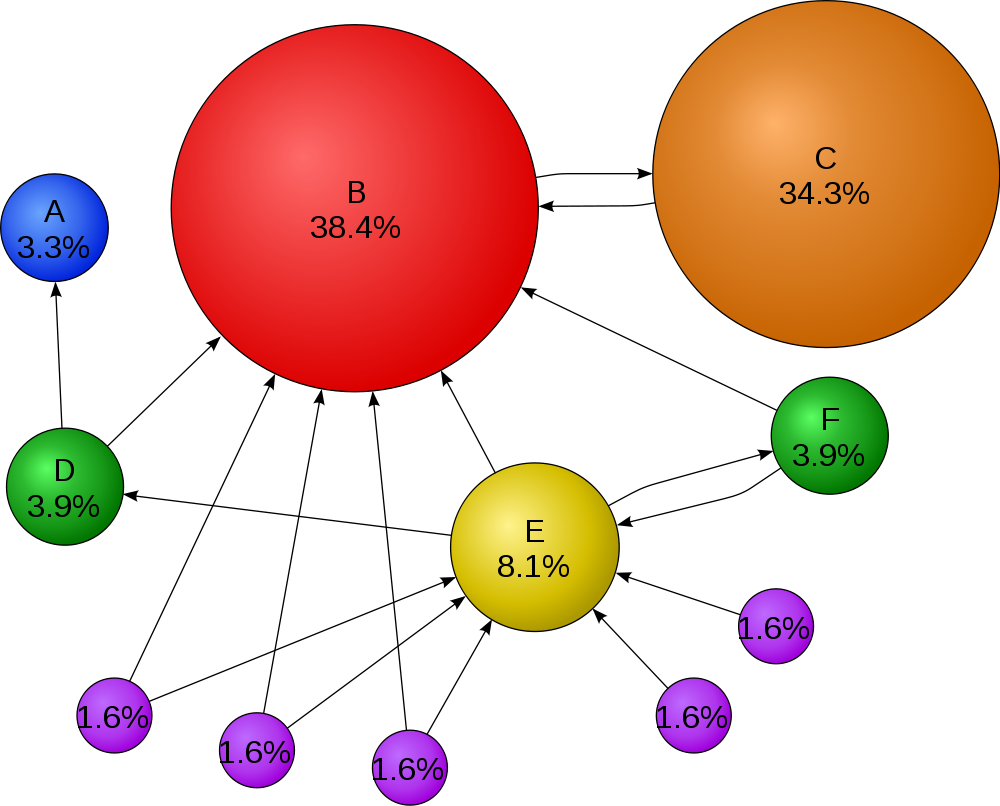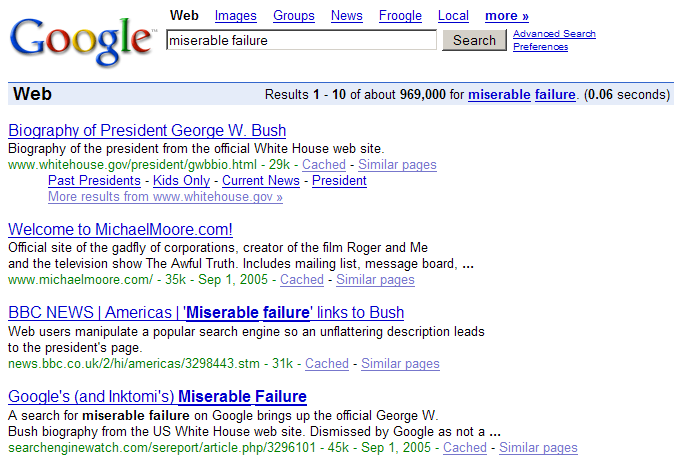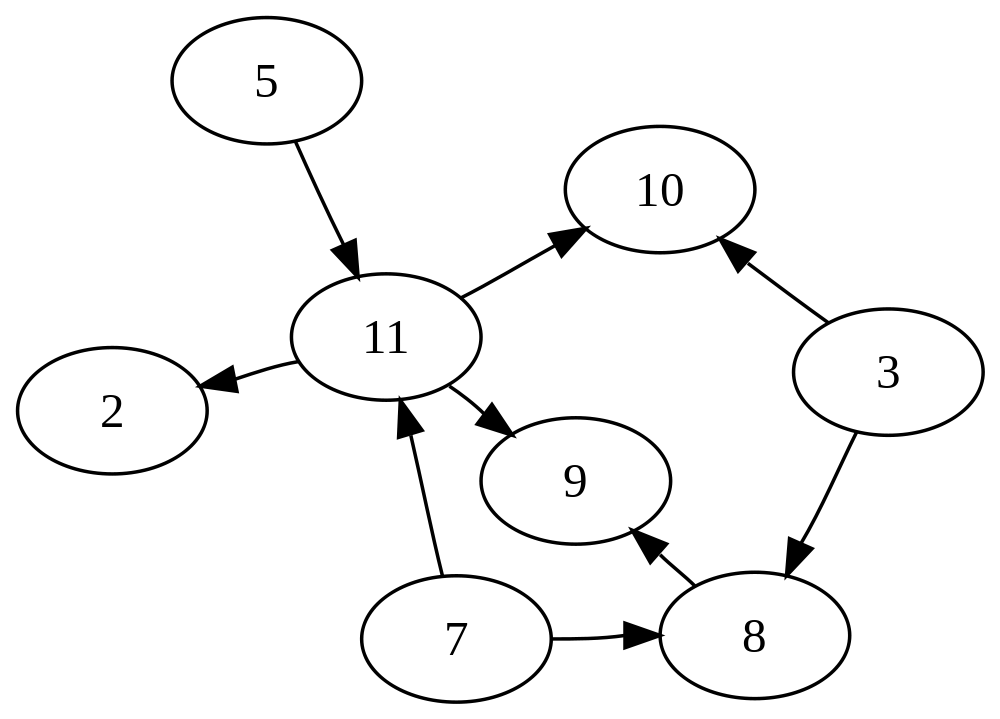2013-04-12-PageRank
Table of Contents
1 PageRank center

1.1 Web page importance notes
- Also used to model importance of people, places… anything that has a reputation
- inbound links are important, but scaled by the importance of the source
- C still important, even though it only has one inbound
2 Random Walks
- Starting from a random page, what is the likelihood of winding up on a target page?
- Starting point captured by initial constant
- Stopping captured by "damping factor" (0.85)

2.1 Original notes
- Original paper did not divide by N
- This gives relative weights of pages, but not a formal probability because sum will not add up to N
- Either way is fine for our purposes
3 Example
B,C,D, all link toABhas PageRank of 0.5, 4 linksChas PageRank of 0.7, 4 linksDhas PageRank of 0.2, 1 link
3.1 Calculations notes
- 0.15 + 0.85 * sum(PR/links for (pr,links) in pages)
- 0.15 + 0.85 * sum(0.5/4, 0.7/4, 0.2/1)
- 0.15 + 0.85 * 0.465
- 0.554525
- From Programming Collective Intelligence
4 Other Pages
- But how did we know the PageRank of other pages?
- Similar to SimRank, we calculate iteratively until convergence
5 Representing Graphs
- Adjacency Matrix
- Represent graph edges in a matrix
| V | A | B | C | D |
| A | 0 | 0 | 0 | 0 |
| B | 1 | 0 | 1 | 0 |
| C | 1 | 0 | 0 | 1 |
| D | 1 | 1 | 0 | 0 |
5.1 Diversion notes
- Take a step back so we can motivate how to express these calculations as linear algebra
- Using linear algebra can help us translate graph concepts to fairly elegant code, as well as realize some optimizations
- Draw
- Symmetric? When?
6 Representing Graphs
- Adjacency List
- For a vertex, list all connections
A [] B [A,C] C [A,D] D [A,B]
6.1 Diversion notes
- You can think of this as keys (vertex) and values (list of vertices)
- When would thinking in key-values be useful? MapReduce
- Back to matrix representation
7 Eigenvector
- PageRank formula divides by number of links
- Modify adjacency matrix typically also normalized such that all rows sum to 1
- PageRank scores are entries in the largest eigenvector of the matrix representation

8 Eigenvector centrality
- Another measurement for graphs, using the simple adjacency matrix
- Relative influence of a node (no normalization)
9 Adversarial
- Source does not want to be discovered
- Patterns are purposefully hidden: so discover the patterns of hiding
- If adversary knows your techniques, they can take advantage of weakness
9.1 Weakness notes
- Reading: paper discovering hiding patterns
- Weakness of pagerank?
- We assume that these links are legitimate.
- What happens if the links are not conveying authority?
10 Google Bomb :slide:center
- Milder forms of adversarial work

10.1 Link farms notes
- Link farms try to create fake links to pages,
- JC Penny's link farm
11 Hubs & Authorities two_col
- Earlier in the web, more structure
- Hubs: collected links to different resources
- Authorities: Gave out specific information
- Score separately?

11.1 Alternatives notes
- Some other interesting network analysis tools
12 HITS
- Authority score
- sum(hub(i) for i in inbound_links)
- Hub score
- sum(authority(i) for i in outbound_links)
- Normalize
- to ensure convergence, square root sum of squares of scores
12.1 Iterative notes
- Sill iterative, but now using inbound and outbound links to judge
- Hubs have outbound links to authoritive pages
- Authorities have inbound links from good hubs
13 Connections
- Connected
- there exists a path from one vertex to another
- Connectivity
- minimum number of vertices to remove to disconnect remaining vertices
- Clustering Coefficient
- Measure of how connected a vertex or group of vertices are
13.1 Robustness notes
- This is used to understand robustness of a system: if an earthquake damaged the Bay Bridge, could we still travel from one point to another?
- What is the connectedness of Oakland and SF?
- Closely related to min-cuts, which is discussed in the book
- Network topology: what happens if a router fails?
14 Clustering Coefficient animate
- How many directed edges are possible between 3 vertices?
- 4 vertices?
v*(v-1)- Undirected?
v*(v-1)/2- Clustering Coefficient: Ratio of actual edges to possible edges
14.1 Reading notes
- Used in Reading this week
v*(v-1)connection to every other node but yourself/2undirected, don't double count connections
14.2 Example

Connectivity Coefficient of 1; 4
14.2.1 Answer notes
- Neighbors of 1: 5 2
- 2*(2-1) / 2 = 1
- Actual links = 1
- Neighbors of 4: 3,5,6
- 3*(3-1) / 2 = 3
- Actual: 0
- If 3-5 connected? 1/3